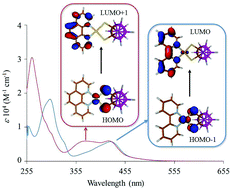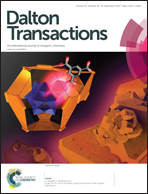New PtII diimine–dithiolate complexes containing a 1,2-dithiolate-1,2-closo-dicarbadodecarborane: an experimental and theoretical investigation†
Abstract
Five new [Pt(N^N)(dtoc)] complexes (1–5; N^N = diimine: 2,2′-bipyridine and its 4,4′-alkyl/aryl-substituted derivatives or 1,10-phenanthroline; dtoc2− = 1,2-dithiolate-1,2-closo-dicarbadodecaborane) have been synthesized and characterized by spectroscopic and electrochemical methods, and by means of X-ray diffraction in the case of complexes 1 and 4. Hybrid DFT and time-dependent (TD) DFT calculations were performed on complexes 1–5 and the previously reported complex [Pt(Ph2phen)(dtoc)] (6; Ph2phen = 4,7-diphenyl-1,10-phenanthroline) both in the gas phase and in the presence of several solvents (CH2Cl2, CHCl3, CH3CN, acetone, THF, DMF, DMSO, and toluene) to gain an insight into the electronic structure of the complexes and explain their experimental features. Theoretical calculations allowed for the determination of structure–property relationships within the series of the six complexes considered, and the prediction of their second order nonlinear optical (SONLO) properties by evaluating their first static hyperpolarizabilities (βtot).



 Please wait while we load your content...
Please wait while we load your content...